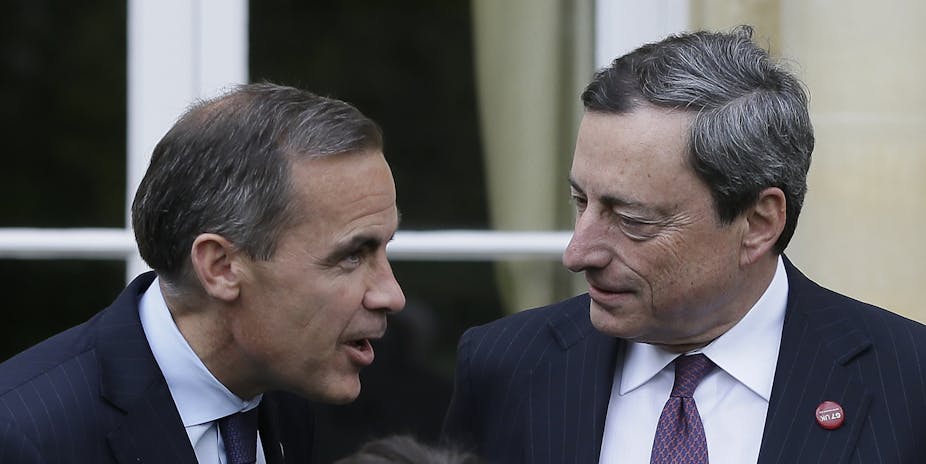Mark Carney and Mario Draghi are fortunate men. Although things may appear difficult now, they could be much worse. War in Iraq, Syria and Eastern Ukraine have the potential to send oil and gas prices shooting up, sharply increasing inflation and putting yet more pressure on battered Western economies. But this has not (yet) happened; Carney and Draghi should share a strong sense of relief.
But this is about all they share, for they face very different policy dilemmas.
BoE steering an unwieldy vessel
In the UK, attention is fixed on when the long expected increase in interest rates arrives. Whenever it does, there will be anxiety at the Bank of England about how households and firms will respond. The impressive recent growth in the UK economy mostly reflects a fall in savings as British consumers continue to borrow heavily in order to maintain consumption.
For the recovery to be sustained there needs to be increases in household income and corporate investment. There is no sign of the former and only tentative evidence of the latter. Until this changes, the medium term outlook for the UK economy is uncertain at best.
Things have been made worse by apparent changes in the way the economy works, leaving monetary policymakers in the uncomfortable position of navigators attempting to steer an unwieldy vessel with unreliable instruments.
There are two interlinked puzzles. Why is inflation so low when unemployment is also low? The “Phillips Curve”, which explains how unemployment is translated into inflation, seems to have changed. And why is productivity growth so very low? This matters because productivity is the main driver of real wages, so incomes will not increase until the corner is turned on productivity.
These puzzles may reflect the rapid growth in self-employment. If this is a genuine change, the outlook for the UK is good as it indicates a surge in entrepreneurial energy that ought, before too long, to be reflected in sustained productivity growth.
But if, as many observers suspect, a lot of self employment is reluctant, reflecting a second best choice for workers who would otherwise be unemployed and who would prefer a permanent job, the outlook is less healthy. In this case, self employment is unlikely to lead to the surge in productivity that the UK economy badly needs.
ECB response is clear
The situation facing Mario Draghi in the eurozone is much worse than that in the UK but the policy decision on the way forward is much easier to call. Output is stagnant or falling across the eurozone; significantly, this applies to Germany as well as the more troubled economies of the region’s south. And inflation is close to zero across the eurozone with deflation in some.
The policy response to this is clear: increase demand. The ECB seems to agree, with Draghi making a recent, albeit diplomatically obscure, call for a lessening of fiscal austerity. Even the president of the Bundesbank, Jens Weidmann, is known to approve of recent wage rises in Germany as a way of boosting domestic demand.
If continued, this may help reverse the structural imbalances that have plagued the Euozone by reducing the German current account surplus and so reducing the deficit in countries such as Greece, Italy and Portugal.
Boosting demand
In the absence of a serious fiscal expansion, monetary policy must be used to boost demand. With interest rates close to zero, this implies Quantitative Easing. QE has been successful in the US and UK.
While it is likely to be successful in the eurozone as well, Draghi cannot simply follow the US Federal Bank and the Bank of England by purchasing large amounts of government bonds. Capital markets are a more important source of borrowing in the US and UK economies than in the eurozone, where bank-financed borrowing is dominant.
Something similar to the Bank of England’s “borrowing for lending” scheme, whereby cheap financing is made available to banks so long as they increase lending, may be more appropriate for the eurozone.
But, given the scale of the problems facing the eurozone, such a scheme would have to be very large. QE purchases in the US and UK were about 40% of GDP. In the eurozone, this would imply a QE program of around €6 trillion. A program like this would deliver the long promised “shock and awe” from the ECB. And something on this scale may be what’s needed to save the eurozone as we know it.

